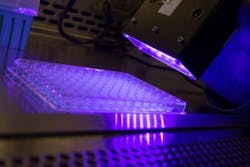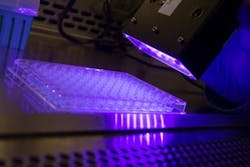Photodynamic therapy method may combat MRSA infection
Researchers at Purdue University (West Lafayette, IN) are testing whether a version of the molecule responsible for transporting oxygen in blood circulation (heme) may, when combined with a photodynamic therapy (PDT) approach, help people infected with methicillin-resistant Staphylococcus aureus (MRSA). Patients in hospitals are especially vulnerable to MRSA infections.
"MRSA infections can cause severe problems for patients recovering from surgery," explains Alexander Wei, a professor of chemistry in the College of Science who is leading the research team. "The challenge that we face is that MRSA responds poorly to multiple antibiotics. Antimicrobial photodynamic therapy offers a promising alternative for combatting MRSA in infected wounds."
Photodynamic therapy involves a compound known as a photosensitizer, which can be activated by visible light to kill diseased cells or bacteria. The method is clinically proven for fighting cancer, but has not yet been developed for treating MRSA infections.
The photosensitizer developed at Purdue is called Ga-PpIX, and is an analog of heme. Ana Morales-de-Echegaray, the lead graduate research assistant on the project at the time, discovered that Ga-PpIX could take over MRSA strains within seconds, leading to their rapid inactivation using a simple light-emitting diode (LED) array that is safe to use on human skin.
Purdue University researchers are testing whether a simple light-emitting diode array that is safe to use on human skin can be used to inactivate methicillin-resistant Staphylococcus aureus (MRSA), one of six 'high-priority' pathogens that the World Health Organization has identified as an imminent threat to public health; here, the light shines above a 96-well plate in a bio-safety hood. (Image credit: Purdue Research Foundation image/John Underwood)
Wei and his collaborator Mohamed Seleem, a professor in Purdue's College of Veterinary Medicine, are working closely with the Purdue Institute of Inflammation, Immunology and Infectious Disease and the Purdue Institute for Drug Discovery to determine if this kind of treatment could work for animals and with other types of skin infection.
The technology is patented through the Purdue Office of Technology Commercialization, and the researchers are looking for partners to continue developing practical applications for the discovery.
Full details of the work appear in the journal ACS Infectious Diseases.

